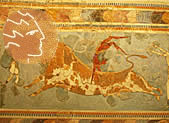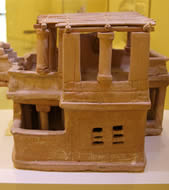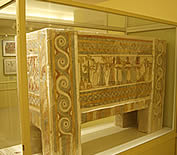






Heraklion Archaeological Museum
The Heraklion Archaeological Museum is one of the largest and most important museums in Greece, and among the most important museums in Europe. It houses representative artefacts from all the periods of Cretan prehistory and history, covering a chronological span of over 5,500 years from the Neolithic period to Roman times. The singularly important Minoan collection contains unique examples of Minoan art, many of them true masterpieces. The Heraklion Museum is rightly considered as the museum of Minoan culture par excellence worldwide.
The museum, located in the town centre, was built between 1937 and 1940 by architect Patroklos Karantinos on a site previously occupied by the Roman Catholic monastery of Saint-Francis which was destroyed by earthquake in 1856. The museum's antiseismic building is an important example of modernist architecture and was awarded a Bauhaus commendation. Karantinos applied the principles of modern architecture to the specific needs of a museum by providing good lighting from the skylights above and along the top of the walls, and facilitating the easy flow of large groups of people. He also anticipated future extensions to the museum. The colours and construction materials, such as the veined polychrome marbles, recall certain Minoan wall-paintings which imitate marble revetment. The two-storeyed building has large exhibition spaces, laboratories, a drawing room, a library, offices and a special department, the so-called Scientific Collection, where numerous finds are stored and studied. The museum shop, run by the Archaeological Receipts Fund, sells museum copies, books, postcards and slides. There is also a cafe.
The Heraklion Archaeological Museum is a Special Regional Service of the Ministry of Culture and its purpose is to acquire, safeguard, conserve, record, study, publish, display and promote Cretan artefacts from the Prehistoric to the Late Roman periods. The museum organizes temporary exhibitions in Greece and abroad, collaborates with scientific and scholarly institutions, and houses a variety of cultural events.
History of the Museum
The first archaeological collection of the town of Heraklion was constituted in 1883 with the initiative of the local Philekpaideutikos Syllogos (Association of Friends of Education), which was headed by the doctor and antiquarian Joseph Chatzidakis. Chatzidakis also obtained permission from the Ottoman authorities to establish the first 'archaeological service'.
The collection was housed inside two rooms in the courtyard of the cathedral of Agios Minas, and by 1900 was enriched with private donations, new acquisitions and finds from the first small excavations and surface surveys. After large-scale excavations began on the island in 1900, the archaeological collection came to include the first important finds from these. Around that time the museum was ceded to the newly established Cretan state and was subsequently moved to the barracks building of the modern nome of Herakleion under the first Keepers of Antiquities Joseph Chatzidakis and Stephanos Xanthoudidis.
The first display room was built in 1904-1907 over the remains of the famous Venetian monastery of Saint Francis, next to the Hounkiar Djami. The antiquities' collection was moved there after the addition of a second room in 1908. In 1912, this small building was given a Neoclassical appearance with the construction of a west wing designed by architect Panagis Kavvadias, Secretary of the Athens Archaeological Society. The collection continued to be enriched by the finds from the great excavations by Greek and foreign archaeologists.
The construction of the current museum began in 1937 on plans by architect Patroklos Karantinos. During the Second World War the museum's antiquities were at great risk, but they were saved thanks to the exertions of Professor Nikolaos Platon. Platon supervised the re-exhibition of the museum's treasures and the museum opened its doors to the public in 1952.
The display illustrated the chronological development of Minoan civilization, the history of archaeological research and of the great discoveries on Crete during the early twentieth century (Knossos, Phaistos and Malia palaces etc), and the prevalent theories on Aegean Prehistory.
In 1962 the museum bought the collection of the Cretan doctor Stylianos Giamalakis, which was displayed on the first floor. In 1964 the new wing was added to the building and the museum's director Stylianos Alexiou subsequently completed the exhibition. In 2000 the museum acquired the Nikos Metaxas collection, part of which will soon go on display.
In 1987 the building received new electricity, air conditioning and fire protection installations, and the skylights in the display rooms were replaced with false ceilings and artificial lighting. A new refurbishment based on plans by architect Alexandros Tombazis began in 2002; it will include the re-opening of the original skylights, new electro-mechanical installations (air conditioning, lighting, security, fire protection etc) and a new wing of storerooms to the north of the building. It will also highlight the remains of the Venetian church of Saint Francis on the east side of the atrium.
Exhibition
The permanent exhibition of the Heraklion Archaeological Museum includes unique works of Cretan art, found in excavations across the central and eastern part of the island and which cover a chronological span of roughly 5500 years, from the Neolithic (5000 BC) to the Late Roman period (late fourth century AD). Most objects date to prehistoric times and to the so-called Minoan period, named after the island's mythical king, Minos. They include pottery, carved stone objects, seals, small sculpture, metal objects and wall-paintings, which were discovered in palaces, mansions, settlements, funerary monuments, sanctuaries and caves.
The exhibition occupies a total of twenty rooms, thirteen on the ground floor and seven on the first floor, and is organised in chronological sequence. Several important subject units, such as Minoan wall-paintings, Minoan sarcophagi and the Giamalakis collection, are presented separately from the overall chronological sequence.
The objects are grouped by find-place and thus give a complete image of Cretan civilization as it developed in different regions and important centres. Explanatory texts, photographs, drawings and models of monuments complete the exhibition
Informations
Summer:
From the 10th of April until the 31 of October 2009
Monday: 13.30-20.00
Tuesday-Friday: 08.30-20.00
Saturday-Sunday and Holiday: 08.30-20.00
The Heraklion Archaeological Museum is one of the largest and most important museums in Greece, and among the most important museums in Europe. It houses representative artefacts from all the periods of Cretan prehistory and history, covering a chronological span of over 5,500 years from the Neolithic period to Roman times. The singularly important Minoan collection contains unique examples of Minoan art, many of them true masterpieces. The Heraklion Museum is rightly considered as the museum of Minoan culture par excellence worldwide.
The museum, located in the town centre, was built between 1937 and 1940 by architect Patroklos Karantinos on a site previously occupied by the Roman Catholic monastery of Saint-Francis which was destroyed by earthquake in 1856. The museum's antiseismic building is an important example of modernist architecture and was awarded a Bauhaus commendation. Karantinos applied the principles of modern architecture to the specific needs of a museum by providing good lighting from the skylights above and along the top of the walls, and facilitating the easy flow of large groups of people. He also anticipated future extensions to the museum. The colours and construction materials, such as the veined polychrome marbles, recall certain Minoan wall-paintings which imitate marble revetment. The two-storeyed building has large exhibition spaces, laboratories, a drawing room, a library, offices and a special department, the so-called Scientific Collection, where numerous finds are stored and studied. The museum shop, run by the Archaeological Receipts Fund, sells museum copies, books, postcards and slides. There is also a cafe.
The Heraklion Archaeological Museum is a Special Regional Service of the Ministry of Culture and its purpose is to acquire, safeguard, conserve, record, study, publish, display and promote Cretan artefacts from the Prehistoric to the Late Roman periods. The museum organizes temporary exhibitions in Greece and abroad, collaborates with scientific and scholarly institutions, and houses a variety of cultural events.
History of the Museum
The first archaeological collection of the town of Heraklion was constituted in 1883 with the initiative of the local Philekpaideutikos Syllogos (Association of Friends of Education), which was headed by the doctor and antiquarian Joseph Chatzidakis. Chatzidakis also obtained permission from the Ottoman authorities to establish the first 'archaeological service'.
The collection was housed inside two rooms in the courtyard of the cathedral of Agios Minas, and by 1900 was enriched with private donations, new acquisitions and finds from the first small excavations and surface surveys. After large-scale excavations began on the island in 1900, the archaeological collection came to include the first important finds from these. Around that time the museum was ceded to the newly established Cretan state and was subsequently moved to the barracks building of the modern nome of Herakleion under the first Keepers of Antiquities Joseph Chatzidakis and Stephanos Xanthoudidis.
The first display room was built in 1904-1907 over the remains of the famous Venetian monastery of Saint Francis, next to the Hounkiar Djami. The antiquities' collection was moved there after the addition of a second room in 1908. In 1912, this small building was given a Neoclassical appearance with the construction of a west wing designed by architect Panagis Kavvadias, Secretary of the Athens Archaeological Society. The collection continued to be enriched by the finds from the great excavations by Greek and foreign archaeologists.
The construction of the current museum began in 1937 on plans by architect Patroklos Karantinos. During the Second World War the museum's antiquities were at great risk, but they were saved thanks to the exertions of Professor Nikolaos Platon. Platon supervised the re-exhibition of the museum's treasures and the museum opened its doors to the public in 1952.
The display illustrated the chronological development of Minoan civilization, the history of archaeological research and of the great discoveries on Crete during the early twentieth century (Knossos, Phaistos and Malia palaces etc), and the prevalent theories on Aegean Prehistory.
In 1962 the museum bought the collection of the Cretan doctor Stylianos Giamalakis, which was displayed on the first floor. In 1964 the new wing was added to the building and the museum's director Stylianos Alexiou subsequently completed the exhibition. In 2000 the museum acquired the Nikos Metaxas collection, part of which will soon go on display.
In 1987 the building received new electricity, air conditioning and fire protection installations, and the skylights in the display rooms were replaced with false ceilings and artificial lighting. A new refurbishment based on plans by architect Alexandros Tombazis began in 2002; it will include the re-opening of the original skylights, new electro-mechanical installations (air conditioning, lighting, security, fire protection etc) and a new wing of storerooms to the north of the building. It will also highlight the remains of the Venetian church of Saint Francis on the east side of the atrium.
Exhibition
The permanent exhibition of the Heraklion Archaeological Museum includes unique works of Cretan art, found in excavations across the central and eastern part of the island and which cover a chronological span of roughly 5500 years, from the Neolithic (5000 BC) to the Late Roman period (late fourth century AD). Most objects date to prehistoric times and to the so-called Minoan period, named after the island's mythical king, Minos. They include pottery, carved stone objects, seals, small sculpture, metal objects and wall-paintings, which were discovered in palaces, mansions, settlements, funerary monuments, sanctuaries and caves.
The exhibition occupies a total of twenty rooms, thirteen on the ground floor and seven on the first floor, and is organised in chronological sequence. Several important subject units, such as Minoan wall-paintings, Minoan sarcophagi and the Giamalakis collection, are presented separately from the overall chronological sequence.
The objects are grouped by find-place and thus give a complete image of Cretan civilization as it developed in different regions and important centres. Explanatory texts, photographs, drawings and models of monuments complete the exhibition
Informations
Summer:
From the 10th of April until the 31 of October 2009
Monday: 13.30-20.00
Tuesday-Friday: 08.30-20.00
Saturday-Sunday and Holiday: 08.30-20.00





